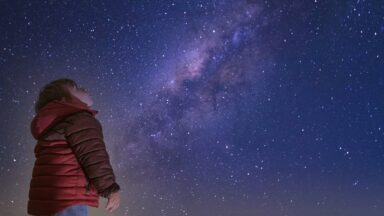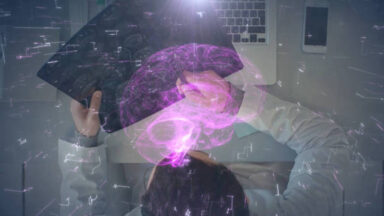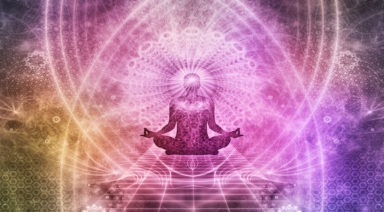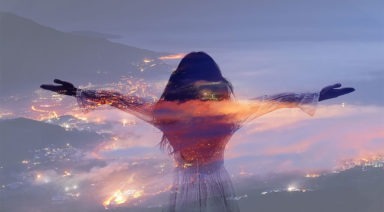Psychedelic Research Finds Ego Exists in The Default Mode Network
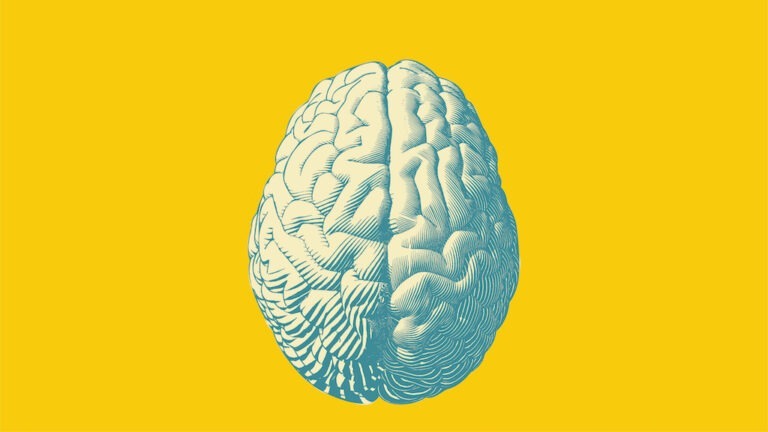
Researchers studying psychedelics have found themselves in the midst of a scientific renaissance as taboos fade and their work yields profound results. One possibly groundbreaking discovery could be a brain mechanism that seems to be responsible for our ego; the Default Mode Network (DMN).
One of the leading names in the world of psychedelic science is Dr. Robin Carhart-Harris, a young, urbane doctor spearheading psychedelic research at London’s Imperial College. Carhart-Harris is the protégé of renowned neuropsychopharmacologist David Nutt, who made waves recently for his work with government-sanctioned psilocybin, the psychoactive ingredient in magic mushrooms.
Along with Amanda Fielding, the famous psychedelic advocate and founder of the Beckley Foundation, the group hypothesized that the psychedelic experience was the result of increased cerebral blood flow, which they believed would stimulate excitation and activity in latent parts of the brain. Instead, they found a significant decrease in activity and blood flow.
Confounded by the results, the group looked at oxygen consumption, noticing there was some validity to their theory, as they saw that parts of the brain were utilizing more oxygen. But there was still a discernible drop in one region that played a role in nearly all brain function – the DMN.

Enter your email below to receive a free ebook
A Guide To Various Plant Medicines and Their Therapeutic Benefits
The DMN is a network of regions in the brain at the top of our cognitive hierarchy, influencing (and often inhibiting) other parts of the brain, especially those involving emotion and memory. Centrally located in the brain, the DMN is a hub of regulatory function, consisting primarily of the prefrontal cortex, posterior cingulate cortex, and inferior parietal lobe.
The DMN is believed to be the home of what Freud called the “ego,” or the part of our brain responsible for judgment, tolerance, reality testing, and a sense of self.
In his book “How to Change Your Mind,” Michael Pollan said it is sometimes referred to as the “me” network and has been shown to light up when a subject is given a list of adjectives to consider, relative to their self-identity. It also lights up during daydreams, magical thinking, self-reflection, and when we receive Facebook likes. It activates “by default” when there is no task at hand.
According to Carhart-Harris, this network is the “orchestra conductor” or “corporate executive” of the brain, preventing signals from being interrupted or interfering with each other.
Freud said the ego keeps anarchic forces on the id in check, and Pollan compares this to the DMN maintaining strict connections on brain function developed over the course of our adult lives.

Brain regions that make up the Default Mode Network
Carhart-Harris says he believes the DMN may have been an evolutionary mechanism, as it doesn’t become active until later in a child’s development, typically around the age of five. As we mature, we tend to use life’s learnings to create “algorithms” in order to respond to various situations throughout the day. Our perception of reality is filtered through these habitual connections that become increasingly ingrained as we grow older.
Aldous Huxley called this the reducing valve of ordinary perception, in which a trickle of information is filtered from all incoming stimuli. This filter, valve, or whatever you want to call it, likely evolved to conserve energy so that we could use it sparingly and save energy for other tasks. In order to efficiently process all of the information received on a daily basis, our brains have to rely on judgments and face-value observations, distinguishing between potential threats and benign situations.
“Each one of us is potentially Mind at Large. But in so far as we are animals, our business is at all costs to survive. To make biological survival possible, Mind at Large has to be funneled through the reducing valve of the brain and nervous system. What comes out at the other end is a measly trickle of the kind of consciousness which will help us to stay alive on the surface of this particular planet.” – Aldous Huxley
But in our modern society, that continuous filtration can develop to a fault, closing off our minds from potential outcomes and possibilities, in turn limiting creativity and developing a narrow-minded worldview. In fact, a NASA study found that 98 percent of us are born creative geniuses, but as we reach adulthood only two percent of society falls into that category. Could the DMN account for this?
Ego Dissolution When the DMN Shuts Off
Accidentally discovered in 2001, the DMN made its debut when Marcus Raichle, using cutting-edge Functional MRI (fMRI) equipment, imaged the cerebral cortex. That same technology, paired with magnetoencephalography, or MEG imaging, was used by the team at Imperial College on subjects under the influence of psychedelics. It was also used by Judson Brewer at the UMass Medical School to image the brain activity of deep meditation states.
Both teams found that when these states were induced and ego dissolution was experienced, the DMN shut down. The dissolution of the ego is an event reported by psychedelic drug users and experienced meditators, so it wasn’t necessarily a surprise when MEG and fMRI scans showed that egoic brain activity correlates directly with DMN activity.
“It appears that when activity in the DMN falls off precipitously, the ego temporarily vanishes, and the usual boundaries we experience between self and world, subject and object, all melt away,” Pollan said.
Buddhists often refer to it as the monkey mind – the internal chatter that leads us astray when we try to silence the interminable flow of opinions and thoughts in our heads. And the monkey mind… you guessed it, that’s probably the DMN flaring when the brain has nothing better to do, defaulting to thoughts about a petty argument you had with your significant other a year ago.
For many, it takes years, or even decades to silence the inner dialogue, but for those who succeed, the fruits of labor are profound. But if one doesn’t have the patience, willpower, or time to devote to a life of meditation, recent research has found that the psychedelic experience, under clinical supervision and the right circumstances, can create the same effect, allowing for new connections to be made within the brain.
Another facet of Carhart-Harris’ theory is that our individual mental states fall somewhere along a scale of entropy. Entropy, in this case, is a measure toward a state of randomness or disorganization. On Carhart-Harris’ scale, high-entropy mental states include those experienced on psychedelics; infant consciousness; early psychosis; and creative or divergent thinking. The low-entropy end includes such states as narrow or rigid thinking; addiction; OCD; depression; and coma.
As we age, the brain forms ‘tenser’ connections based on a slower drip from the reduction valve of perception. Carhart-Harris believes this can lead to states of depression, as the valve shuts out various possibilities, closing us off and increasing introspection. The ego eventually turns on itself and “gradually shades out reality.”
A psychedelic experience increases entropy in the brain, loosening those bonds and opening the mind to a deluge of possibilities, many of which can be confusing or bizarre, hence the hallucinations and strange thoughts. But this could explain why recent studies have found that psilocybin from magic mushrooms can cure depression and act as a reset mechanism in the brain, or that potent doses of Ayahuasca or Ibogaine can cure heroin and cocaine addicts of a lifetime of addiction.

Above: a simplified model of the number of neurological connections in the brain between a placebo on the left and psilocybin on the right.
An inundation of new mental states and potential realities can not only free subjects from depression but can also spark creative thought and innovation. One of the biggest hindrances to creativity is a close-minded perspective and the immediate rejection of seemingly fantastical ideas. But it’s not your fault, you can blame it on the DMN.
That’s why Silicon Valley CEOs have touted the creative genius found in the psychedelic experience, ever since Steve Jobs credited LSD for his success in founding Apple.
It should be noted, however, that psychedelics are nothing to take lightly. It’s no coincidence that Carhart-Harris’ entropic brain scale includes early-stage psychosis on the same end as psychedelics. Used improperly and carelessly, psychedelics can devastate the mind, leading to long-term psychological damage in rare instances. Albert Hoffman, who discovered LSD, even expressed occasional regret in his life for the damage caused by its unfettered use.
But if we view these substances as tools or medicine, rather than recreational drugs, we can use them to our advantage. And as science continues to dissect and understand the ways they affect our cognitive function, discoveries of networks such as the DMN will undoubtedly lead to a better understanding of our minds and the ability to lead enlightened lives.
Strongest Psychedelic Known to Man Now Being Used in Clinical Trials

The world’s first regulated clinical trial of DMT clears the way for Earth’s most powerful psychoactive drug to join the psychedelic therapy revolution.
DMT, or N, N-Dimethyltryptamine, is a highly potent hallucinogen that naturally occurs in many plant species, including in one of the plant ingredients of ayahuasca. It can also be synthetically produced in a laboratory.
DMT is known for inducing intense metaphysical trips, which are reportedly similar to near-death experiences. Having been used underground in the west for decades, it is now attracting the interest of pharmaceutical companies and scientists looking to investigate its potential mental health benefits.
Jay Waxenberg is the director of the DMTx program at the Center for Medicinal Mindfulness. Based in Boulder, CO, it was one of the first centers to offer legal psychedelic therapy in the U.S.
“DMT is actually the most powerful psychedelic on Earth that we’re aware of, and what makes it special and different from other psychedelics is that it’s endogenous, which means it’s produced within our own bodies. It’s also produced in nearly every ecosystem on Earth — it’s everywhere, it’s all around us – which is also kind of leading to what is really unique about it, the extent of a DMT experience, it’s at most 20 minutes,” Waxenberg said.
While there is a wide range of phenomena experienced during a DMT trip, there are some fascinating common hallmarks.
“This alternate reality experience, or this experience that people will call ‘realer than real.’ It’s a reality similar to our own, but completely different,” Waxenberg said. “Some of the elements within that would be the entity encounters, which is very common for people; intense geometric, hyperbolic shapes; and out-of-body, traveling to the center of the universe; ego-dissolution, ego death; these are really common experiences under it.”
While advocates have been reporting profound healing benefits for decades, there have not been any clinical studies on DMT due to its status as a Schedule 1 controlled substance, until now.







